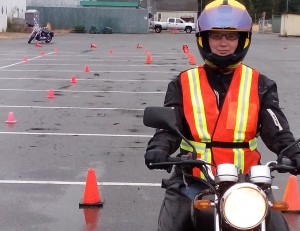What do space cushions have to do with motorcycle riding?
By Lookout on Jul 07, 2014 with Comments 2
This was it; 2014 would be the year I learned to ride a motorcycle and ride with the pack.
None of my friends would ride with me unless I took a proper “learn to ride” course. And, as if the hog gods were listening, an ad appeared in the Lookout newspaper for “Learn to Ride” motorcycle training.
I could almost hear leather-clad angels cooing “ahhhhh.”
With my application accpeted and Class 6/8 Learner’s License obtained, I was set for the two evenings of four hour classroom theory, and two full days of learning on a 250cc motorbike – courtesy of Learn to Ride Motorcycle Training Ltd.
In hopes of staying ahead of the pack, I eagerly studied the ICBC “Learn To Ride Smart” booklet.
A few days later, I was seated next to four other rider wannabes at the Econo Lodge Gorge View board room, our eyes set on Richard Beaumont, a Petty Officer Second Class sailor who has 14 years experience on two wheels, and seven as a certified trainer.
He tossed out bike jargon that I found novel such as “space cushion.” No, not a silver lamé throw pillow, but a descriptive term for the necessary distance in front of you that allows time enough to stop or react safely.
Or “road snakes,” the literal meaning sounds more fantastical than the actual. It pertains to the wiggly tar lines meant to repair the cracks in the road. They are slippery, especially when wet and are to be avoided where possible.
In terms of real world threats to a motorcyclist, road snakes are on the lower end of our worries. We learned that everything is a potential hazard when you are riding, and it is best to practice SIPDE: scan, identify, predict, decide and execute.
From the classroom, we ventured to a parking lot on base where we each straddled a loaner motorbike. For the others it came roaring to life easily- I kept forgetting to turn the ignition key or the gas switch (petcock) or pull the clutch in or set the choke. The learning curve for learning to ride is steep and unforgiving.
Slow speed control, while not the stuff to smatter bugs on one’s faceplate, trains a rider to start smoothly from a full stop. It was tough trying to find the sweet spot where the engine begins to engage as the clutch is released. My left hand ached for a week.
Coordination of the controls didn’t happen flawlessly. The challenge outweighed my patience.
Many of the shiny new cones lining the course – making a figure eight, slalom, and u-turn – were now wearing tire tracks.
We buzzed and choked, stuttered and stalled, and eventually traversed through the cones seamlessly. The course design ensured our skills progressed as the hours ticked by. By the end of day one, we made a full trip around the base.
On the second day we revved up the throttle and went faster, adding to our skills higher speed turns, emergency stopping, and debris avoidance.
The rule “you will go where you look” is true. I experienced a few gut wrenching moments that thankfully did not lead to any mishaps.
To round out the morning we took a mock skills test designed like the course ICBC puts new riders through. Once we had ridden through the course to the satisfaction of our instructor we were cleared to ride on the street in the afternoon.
PO2 Beaumont laid out the rules, the route we would take, and who would lead the group.
We rode in formation to downtown Victoria and back again. We stopped every so often to discuss what was done right or wrong, what needed specific improvement, and who would lead the next part of the ride.
We trialed lane positioning, safe lane change, and shoulder checks.
By the end of the Sunday, we were ready to take ICBC’s motorcycle skills and license tests. We also received a MARPAC Riders patch to display our membership. When we signed up for the course we also became part of the MARPAC Riders Club.
The club’s mandate is to provide these three aspects of club stewardship:
- to promote the social aspect of group riding,
- to assist in self-help repair, and
- to provide a mentorship program geared towards new
- riders.
The club goes a step further by providing a supervisor to ride with a new rider, and to help them practice for the skills test.
To ride as a fully licensed biker will take two more tests. The skills test and the Class 6 road test. For now, I just want to keep practicing so I don’t lose the skills I worked so hard to gain.
The entire experience was intense and required determination and fortitude. PO2 Beaumont’s shows a clear dedication to teaching how to ride safely, and the course follows a progressive learning curve. I was able to build my skills and confidence with each module. I am thrilled and cautiously optimistic about my future as a competent and safe motorcycle rider.
For more information on upcoming course times and registration please visit: www.learntoride.ca
Shelley Fox, Staff Writer
Filed Under: Top Stories
About the Author:







Our campervan seat cushions are made with premium materials, designed to provide the ultimate comfort for your road trip adventures. Whether you’re traveling long distances or just exploring the beautiful city of Vancouver, our cushions will help you stay comfortable and relaxed throughout your journey.
Well written, interesting and informative. Makes me want to ride!